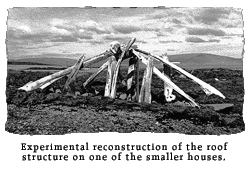|
Northern Vignettes
Arctic Harpoons
Beechey Island
Crystal II
Deline/Fort Franklin
Fort Hope
Fox Moth
Kellet's Storehouse
Naujan
Old Fort Providence
Old Fort Reliance
Stone Church
Thule Village
Yellowknife
Fort Journal
|
One of the routes taken by early Inuit explorers followed the coasts of Lancaster Sound to Baffin Bay and northwestern Greenland. At many places along these coasts they built winter villages, which were occupied for several years or even decades. The design of their winter houses was based on a traditional Alaskan log-house pattern, dug into the ground for protection from the cold, heavily covered with insulating turf, and entered through a narrow tunnel. Lacking logs for construction, the Thule people of Arctic Canada built their houses of boulders; floors, kitchen alcoves and raised sleeping platforms were paved with flagstones; and the roof was supported with whale bone rafters. Four ancient Thule villages lie within walking distance of the present settlement of Resolute Bay. At least three of them relate to a very early period of Inuit occupation, and some of the earliest houses may have been built shortly after A.D. 1000. When Resolute Bay was settled in the 1940s, the collapsed houses of the ancient villages bristled with the bones of many bowhead whales; the abundant animal bones found in the garbage deposits around these villages show that the occupants were successful hunters of seal and walrus as well as whales. It is reported that these bones were interpreted as evidence for excellent local hunting potential, and the existence of the ancient villages influenced the selection of Resolute Bay as a location for a High Arctic Inuit settlement. Unfortunately, the animal bones around these villages are not evidence of local hunting potential, but of an environment which was considerably warmer and richer than it is today. When cooling climatic conditions set in, at some time after A.D. 1500, the Thule people abandoned their villages here and throughout the islands north of Lancaster Sound. The British explorers who passed through the area in the nineteenth century found the High Arctic unoccupied, except by occasional Inuit hunting or exploring expeditions from homelands in the southern Arctic archipelago. Archaeological excavations were carried out at the Resolute Bay villages in 1949-53, and since that time the sites have suffered considerably from vandalism. Most of the whale bones have been removed as souvenirs or as carving material, holes have been dug by people searching for artifacts, and the largest village was damaged by the construction of a gravel parking area and viewing platform built for the 1970 visit of the Royal Family. Despite the vandalism, a great deal of information on early Inuit history still lies buried in these villages. They are protected by the Northwest Territories Archaeological Sites Regulations. Acknowledgments: Text and photos by Robert McGhee, Archaeological Survey of Canada, Canadian Museum of Civilization, Hull, Quebec. |
 One
of the most remarkable periods of Inuit history occurred about 1000
years ago. At that time, the climate was slightly warmer than present,
and summer sea ice was less extensive. The relatively ice-free seas
of the Canadian Arctic, and the large populations of whales and
other sea mammals inhabiting them, tempted ancestral Inuit to begin
moving eastward from their Alaskan homelands. Between about A.D.
1000 and 1200, the Inuit occupied most of Arctic Canada and Greenland.
These early Inuit are known as Thule people (pronounced Too-lee),
since their archaeological remains were first discovered near the
Greenlandic settlement of that name.
One
of the most remarkable periods of Inuit history occurred about 1000
years ago. At that time, the climate was slightly warmer than present,
and summer sea ice was less extensive. The relatively ice-free seas
of the Canadian Arctic, and the large populations of whales and
other sea mammals inhabiting them, tempted ancestral Inuit to begin
moving eastward from their Alaskan homelands. Between about A.D.
1000 and 1200, the Inuit occupied most of Arctic Canada and Greenland.
These early Inuit are known as Thule people (pronounced Too-lee),
since their archaeological remains were first discovered near the
Greenlandic settlement of that name.